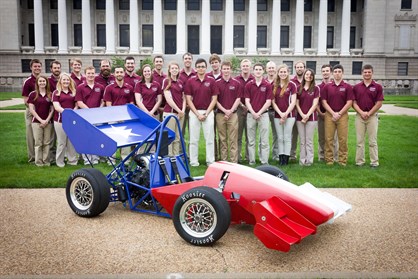
Each year engineering students at Texas A&M University participate in a senior project that will tie together and challenge all the skills they have achieved while pursuing their degrees. These projects are designed to showcase not only the student’s capabilities but also each department’s world class learning opportunities. In one of the projects, the Department of Mechanical Engineering sponsors students to work on a Formula SAE race car.
This project challenges students to apply not only mechanical engineering concepts but also several other engineering disciplines ranging from aerodynamics to electronics engineering. Through a multi-disciplined project, the students learn how all the systems within a vehicle work best together.
“Industry requires collaboration of individuals across many disciplines,” said Dr. Peter Hamilton, associate professor of practice in mechanical engineering. “During most of their academic experience students are graded on their individual contributions. These senior projects teach students to collaborate much as they will be required to do when they leave A&M and begin their engineering careers.”
Senior projects such as the SAE car test the students design skills and give them a direct understanding of how those designs are applicable in a real world scenario.
“There are all kinds of systems that make up the car, whether its structures like the chassis that have to resist all the bending and vibrations of the car, or the dynamic spinning systems such as the engine and intake that have suck in as much air as quickly as possible and push it out even faster, to make the car move,” said junior Gill Lipton who is the driver of the SAE car.
This project is truly interdisciplinary and is designed to highlight student’s capabilities. Starting at the initial meeting in the fall semester students begin by writing the functions they must provide while meeting the competition rules.
Formula SAE competitions have been held since 1979, when according the SAE website, Mark Marshek contacted SAE and pitched the idea of adding an event to the Mini Baja competition. In 1980 a lack of funding caused the competition to cease, but thanks to a grassroots push the event underwent restructuring which allowed more teams to compete under new rules and a new name, Formula SAE. Much like the original race structure had to adapt to succeed, what was originally a strictly senior project at Texas A&M, eventually evolved to allow any student at any level to participate in the project.
“Starting off as a freshman at A&M I knew I wanted to be a part of the FSAE team,” Lipton said. “It’s one of the reasons I choose A&M to pursue my education. As a freshman I started volunteering with the team and getting involved however I could. After I proved how dedicated I was, the project eventually set up an official underclass volunteer system to allow any engineering student to join the team.”
The Formula SAE project begins in the fall semester and by spring break the cars are ready for paint. Once assembled, car testing begins.
“During testing things get dicey because things break and we have to fix them quickly,” Lipton said. “For instance, I hit a cone driving about 50 miles an hour on the practice course. It caused the front wing to snap and we had to fix it according to the specs within days of the competition.”
The culmination of each team’s hard work comes annually at the FSAE competitions as they face schools from around the world. At the 2015 competition the Texas A&M team placed 12th in business presentation, 39th in cost, seventh in design, ninth in skid pad, second in acceleration, second in autocross and did not finish in endurance and efficiency.
The team finished 14th overall out of 65 teams who made it to the competition with their finished cars. Although building the car is a lot of hard work and commitment, rules of the competition dictate each year a new car must be built from scratch.
“We are constantly looking for new students from any engineering major to join our team,” said Lipton. “As it stands now we have a truly interdisciplinary design project. Texas A&M’s mechanical engineering department puts a strong emphasis on bringing all other departments together and exposing them to multiple disciplines so that when students graduate we are ready to lead the way in the engineering professions.”